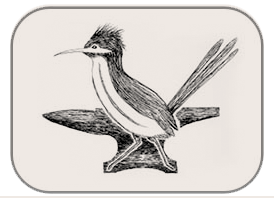Shadow Sculpture FAQ
In it’s simplest form, a Shadow Sculpture is an artwork that looks like one thing, yet casts the shadow of something else. I love the challenge of creating these!
What is a Shadow Sculpture?
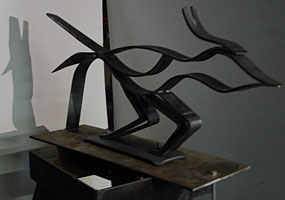
Desert Dwellers
Jan. 2013
In it’s simplest terms, a Shadow Sculpture is an artwork which looks like one thing when viewed directly, but which casts the shadow of something else.
An example is Desert Dwellers – this work looks like a stylized roadrunner, but casts the shadow of a howling coyote. It synthesizes and contrasts two different animals that we often see in our local deserts.
In schematic form, a Shadow Sculpture is set up, and works like this:
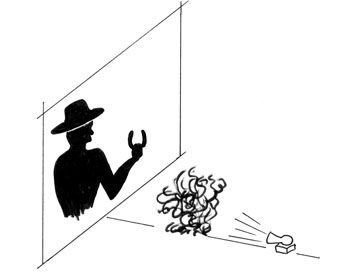
What are your types of Shadow Sculptures?
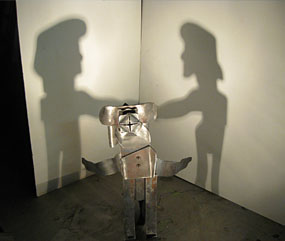
Boy-Girl in Ribbons
Jan. 2012
I have made two basic types of Shadow Sculptures, one-shadow and two-shadow pieces (I also call these 1-S and 2-S pieces).
A one-shadow piece has one light source, casting a single shadow. Usually, the shadow is cast upon a vertical wall or screen behind the Shadow Sculpture. This is what is shown in the schematic drawing above. 1-S pieces make up the majority of my Shadow Sculptures — creating a 2-S piece is significantly more difficult.
The much more complex, much more challenging two-shadow piece (2-S) has two light sources, casting two different shadows. These light sources are usually at 90 degrees to each other; the artwork is intended to go into a corner, so that the lights can cast the two separate shadows. In schematic form, it looks like the following:
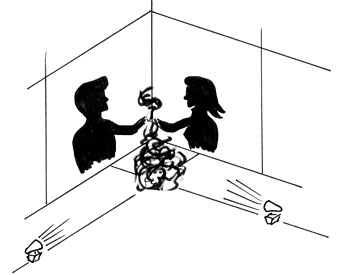
Where did the concept of a Shadow Sculpture come from? Who invented it?
It is unknown to me where the concept came from. Maybe it harks back to when we were kids, making finger shadows in front of a light source. The first Shadow Sculpture which I saw was in a gallery in Loveland, Colorado, several years ago. I was intrigued by that piece, and decided to try to create one.
The first Shadow Sculpture which I created [Oct. 2009] was in memory of the noted southern California farrier Bob Nett – people who have seen the piece have interpreted the direct view of it as cactus, desert, or just as abstract. It casts a shadow that replicates an iconic photo of Bob, in his cowboy hat, holding a horseshoe.
Why do you enjoy creating these?
Simple: the attractive challenge of integrating two disparate ideas into one artwork, being able to communicate those disparate ideas to the viewer. The challenge of integrating the two ideas really resonates with me. And, if it goes into a 2-S (two-light/two-shadow) piece, the challenge and reward (if successful) kick up a level.
Much of the enjoyment of creating shadow sculptures lies in the challenge of fusing two ideas together — the idea embodied in what the artwork looks like when viewed directly, versus the idea portrayed in the shadow. To me, the most enjoyable and fun pieces emerge when the two ideas offer interesting contrasts. If I can cause the viewer to engage those ideas, then the artwork has succeeded.
What ideas are incorporated into a Shadow Sculpture?
The most interesting Shadow Sculptures present a set of contrasting ideas, maybe have an element of surprise or other strong feeling.
First, let’s define a couple of terms: direct view and shadow view. The “direct view” is what you see when looking directly at the piece — in the example above, the direct view is a stylized roadrunner. The “shadow view” is what the cast shadow represents; again using the example above, the cast shadow is of a howling coyote.
My interest is to have the direct view present a specific image, rather than an abstract presentation. This preference ties to my interest in creating works which incorporate contrasting ideas in the direct versus the shadow view.
In my philosophy about art, the best art is not just all on the surface — there are multiple, accessible ideas which are not seen upon first glance. Such a piece invites the viewer to engage, examine, and interact with the artwork, creating a relationship with the viewer. Integration of multiple ideas is my goal when creating these pieces – sometimes I can approach this goal, which is exciting to me.
What inspires these? Where do your ideas come from?
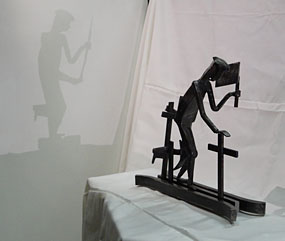
A Veteran Remembers
Sept. 2012
There is no single answer to this. Inspiration for my shadow sculptures comes from a wide variety of sources: some times it’s an event or holiday (Fourth of July, Veteran’s Day), some times it’s picking a theme and trying to create something that addresses that theme, and some times it’s just serendipity.
An example popped up last year when the noted cartoonist Jack Cassady sent me a photograph of an old veteran, with a drawn-in shadow of that veteran as a younger soldier. Somehow, it immediately jumped into my mind that I could create that in steel: that idea became “A Veteran Remembers.”
Inspiration is all around us, if we are open and receptive. By keeping a challenge in mind, often an idea will leap forward when least expected: in the shower, while jogging, etc. Then it becomes a second challenge to remember the idea!
How do you create it?
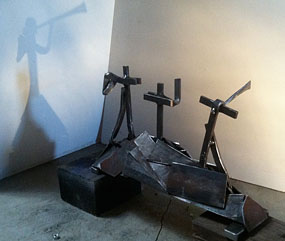
Mockup/Model for “Golgotha”, welded up
out of scraps
Feb. 2012
There are two parts to this question: creating the design, and creating the artwork itself.
The starting point is usually an idea or set of ideas that I want to create a Shadow Sculpture to present. Defining a design that addresses those ideas involves sitting down with a ream of paper: start doodling out ideas/thoughts of how to implement the ideas. Some times it comes immediately, but sometimes I get to the end of the ream and either give up or put it away. Sometimes I have to admit that no design has presented itself.
Working at the pile of paper until a recognizable artwork emerges that integrates the ideas for the direct view and the shadow view, this stage of the artwork is a rough pencil drawing. The next step is to play with the initial design, to try to come up with a better way to implement it. This often involves putting it away for a while, so that my subconscious can meditate on it (I call this the “fermenting phase”).
If I’m fortunate and see a way to implement the ideas, the next stage is a refinement phase. The initial design implementation is expressed in a rough pencil sketch. Refining the design means that I have gone on to improve the design on paper, and also to begin to make models or mockups. Many times this step goes into a complete model, using up material from my scraps pile (a good way to whittle down that ever-growing scrap pile). The mockups and model are important: the shadows and geometries in the three-dimensional world are often close but not exactly what I envisioned, so these really help refine the process.
Creating the artwork involves using the processes of blacksmithing — forging hot steel. It really helps to have the model at this stage, because that lets me concentrate on the work of blacksmithing. It often involves a lot of diddling and tweaking to get things scaled up and exactly right. That diddling can be frustrating, but also quite engaging.
Do you have favorites?
Yes: those that people respond well to.
My favorite situation is when I can engage the viewer, capture his or her interest. If we can interact, if the viewer feels a strong emotional feeling, then the artwork is successful. To achieve this, it helps to have a strong contrast between the idea in the direct view and the shadow view. Especially if the shadow is unexpected. And it is a huge joy to incorporate fun ideas.
I feel that the best of my Shadow Sculptures incorporate strong contrasts in ideas between the direct view and the shadow view. An example of this was “Golgotha,” which showed the three rugged, forlorn crosses on the hills of Golgotha. In contrast to this sadness, the shadow showed an angel heralding the resurrection – a strong contrast of joy versus sadness and death.
Can I use just any light source?
Both the type of light and its location need to be very specific. The light source needs to be one which casts good sharp shadows. Some nice point-source lights can be found at Ikea and Fry’s Electronics.
The location of the light source is also very specific to the sculpture. Both need to be positioned carefully in order to create the intended shadow.
How can I get one?
These will be available from time to time, either from me or from gallery sources. At this time I have not made enough pieces to distribute through galleries, but I am hoping that will change soon.
There is a portfolio of ideas in my working-ideas notebook, which I hope to realize in steel in the future. Some of these are already in the planning stage, so check back from time to time, to find out what’s new.
Commissions are highly welcomed! It is a challenge to respond to someone’s idea of what they might want — and as you’ve seen above, I enjoy challenges. Please note, however: not all ideas and concepts are realizable. Our collaborative starting point will be to figure out if I can create an artwork that encompasses your ideas.
If you see a sculpture that you like but would want a different light location/geometry, or a different size, I would welcome a commission to create a re-design adapted to your specific situation.
Please use the contact form on the web site to contact me about shows, commissions, and availability of Shadow Sculptures.
